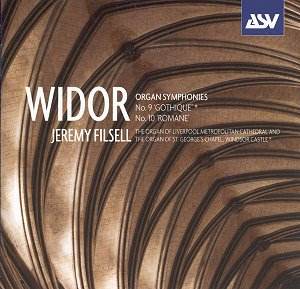Some time ago, the
brilliant English organist Jeremy Filsell
released a CD of his own Cochereau improvisation
transcriptions recorded in Liverpool
Metropolitan Cathedral. It is, in my
opinion, one of the most brilliant British
organ discs of the decade until now.
One of the reasons that it is so successful
is the ingenious choice of instrument,
the 1960s Walker in Liverpool's Metropolitan
Cathedral, which manages to aesthetically
match so well the sound of the post-1960s
Notre Dame organ, without the claustrophia
of Francois Carbou's legendary recordings.
Here Filsell returns to Liverpool for
a dazzling performance of Widor's masterful
10th symphony. But the difference with
this CD is that the aesthetics of the
music and of the chosen instruments
are less happily matched.
I find the choice of
organ for the 9th symphony more problematic
than that for the 10th however. Another
organ from the sixties, the Sydney Campbell
designed Harrison at Windsor proves
a less than ideal choice for Widor's
music. The acoustic is relatively meagre,
the foundations likewise, the reeds
seem rather opaque, the tutti slightly
ugly and the whole just lacking in elegance.
Filsell seems ever so slightly edgy
in the gorgeous Andante sostenuto, (and
the solo Flute is just not voluptuous
enough), and more so in the astonishingly
fast fugue. True, in the 9th symphony,
Widor doesn't suggest any metronome
marks, but I think Filsell would struggle
to argue a case for such a hectic approach.
In the Romane, the Liverpool organ,
in its cavernous acoustic provides a
better situation; the organ is more
dramatic and a touch more gallic - though
still very much more Gonzales Gallic
rather than Cavaillé-Coll. Interestingly
Filsell plays the Romane in general
with more breadth than the Gothique,
and I enjoyed it much more, even if
the use of the Orchestral Trumpet in
the last Final is slightly crass; Cavaillé-Coll's
horizontal reeds behave completely differently,
complementing the tutti, rather than
swamping it. On the whole though, Filsell's
handing of the freedom inherent in music,
due to Widor's use of the plainchant,
'Haec Dies' which permeates the entire
symphony, is extremely well done.
The question of musical
aesthetics and how they relate to organ
aesthetics is one I return to time and
again in these reviews. Jeremy Filsell
could quite justifiably argue that there
are already plenty of recordings of
this music on the late Cavaillé-Colls
for which they were written. Well, he'd
be right, but there are many other fabulous
organs either by Cavaillé-Coll
or his contemporaries which are far
less recorded. A CD of Widor's 9th and
10th symphonies from St Etienne in Caen,
or on the two largest Schyven organs
in Belgium - Notre Dame de Laecken and
Antwerp Cathedral- would whet my appetite
more than on the organs recorded here.
To turn the question on its head, does
that mean that Widor is the wrong music
to play on these organs? I believe itís
a question of circumstance. If I were
to attend a recital in Windsor and Mr
Filsell were to play Widor's 9th symphony
I would be very happy to listen and
would probably enjoy it much more. But
a CD recording, which theoretically
will endure repeated listening for eternity,
is another matter and it is in such
a circumstance that I miss the aesthetic
link. That is why I believe different
organs should have been chosen in this
instance. Unfortunately nothing about
the organs, or why they were chosen
is included in the booklet. The essay
by Ates Orga discusses, inevitably,
the importance of Cavaillé-Coll
in the creation of the music.
Despite my moans, this
is worth buying due to Filsell's stunningly
virtuosic playing and mastery of the
music. My first choice for recordings
of this literature remains Ben van Oosten's
spacious and insightful readings on
Dabringhaus und Grimm. But if you already
have these, this would be a nice library-filler
in order to hear a quite different but
admirably compelling approach.
Chris Bragg


